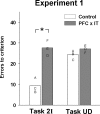Prefrontal cortex function in the representation of temporally complex events
- PMID: 18400892
- PMCID: PMC6670454
- DOI: 10.1523/JNEUROSCI.0633-08.2008
Prefrontal cortex function in the representation of temporally complex events
Abstract
The frontal cortex and inferior temporal cortex are strongly functionally interconnected. Previous experiments on prefrontal function in monkeys have shown that a disconnection of prefrontal cortex from inferior temporal cortex impairs a variety of complex visual learning tasks but leaves simple concurrent object-reward association learning intact. We investigated the possibility that temporal components of visual learning tasks determine the sensitivity of those tasks to prefrontal-temporal disconnection by adding specific temporal components to the concurrent object-reward association learning task. Monkeys with crossed unilateral lesions of prefrontal cortex and inferior temporal cortex were impaired compared with unoperated controls at associating two-item sequences of visual objects with reward. The impairment was specific to the learning of visual sequences, because disconnection was without effect on object-reward association learning for an equivalent delayed reward. This result was replicated in monkeys with transection of the uncinate fascicle, thus determining the anatomical specificity of the dissociation. Previous behavioral results suggest that monkeys represent the two-item serial compound stimuli in a configural manner, similar to the way monkeys represent simultaneously presented compound stimuli. The representation of simultaneously presented configural stimuli depends on the perirhinal cortex. The present experiments show that the representation of serially presented compound stimuli depends on the interaction of prefrontal cortex and inferior temporal cortex. We suggest that prefrontal-temporal disconnection impairs a wide variety of learning tasks because in those tasks monkeys lay down similar temporally complex representations.
Figures




References
-
- Browning PG, Gaffan D. Impairment in object-in-place scene learning after uncinate fascicle section in macaque monkeys. Behav Neurosci. 2008;122:477–482. - PubMed
-
- Browning PGF, Easton A, Buckley MJ, Gaffan D. The role of prefrontal cortex in object-in-place learning in monkeys. Eur J Neurosci. 2005;22:3281–3291. - PubMed
-
- Browning PGF, Easton A, Gaffan D. Frontal-temporal disconnection abolishes object discrimination learning set in macaque monkeys. Cereb Cortex. 2007;17:859–864. - PubMed
-
- Buckley MJ, Gaffan D. Perirhinal cortex ablation impairs configural learning and paired-associate learning equally. Neuropsychologia. 1998;36:535–546. - PubMed
-
- Buckley MJ, Gaffan D, Murray EA. Functional double dissociation between two inferior temporal cortical areas: perirhinal cortex versus middle temporal gyrus. J Neurophysiol. 1997;77:587–598. - PubMed
Publication types
MeSH terms
Grants and funding
LinkOut - more resources
Full Text Sources
